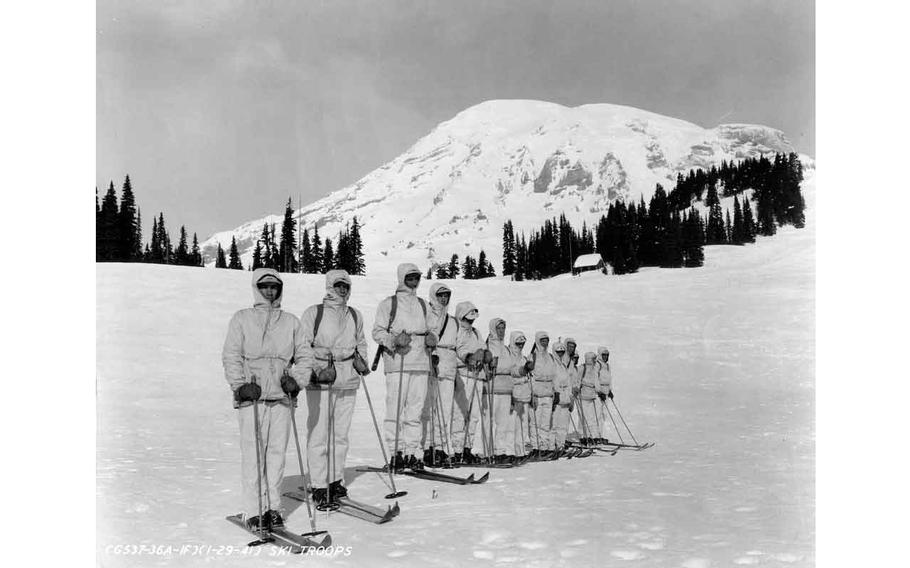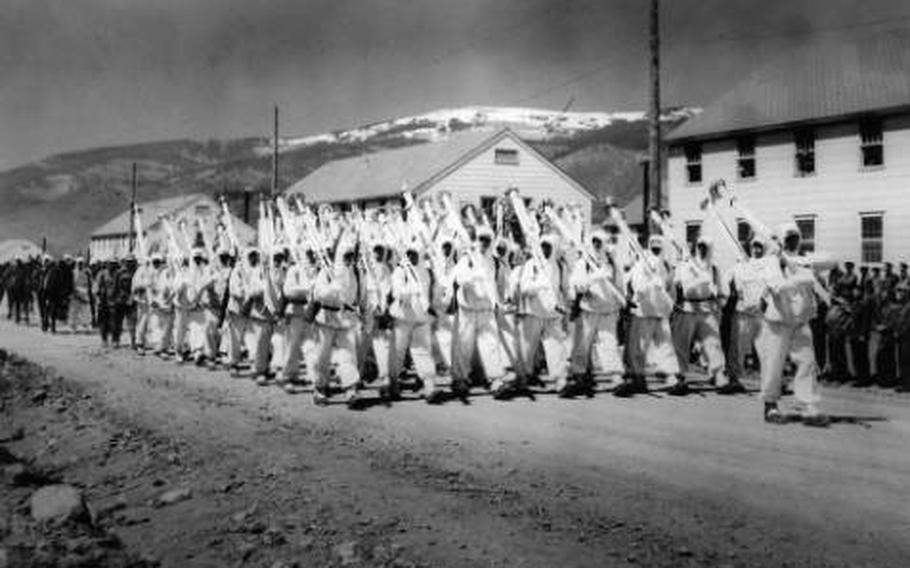
Pioneers of the 10th Mountain Division, the 87th Mountain Infantry Battalion, training in the United States in 1941. The unit was compromised of skiers, climbers and other outdoorsmen who trained vigorously. (World War II Today/U.S. National Guard)
(Tribune News Service) — The saga of the 10th Mountain Division “ski troops” who trained for mountain warfare at Camp Hale near Leadville, Colo., during World War II, and their subsequent combat heroism in northern Italy, has been told many times through movies and books.
The Colorado Snowsports Museum in Vail has helped keep their memories alive for five decades with artifacts, dioramas, photos and films, in part because 10th Mountain veterans helped found dozens of U.S. ski areas after the war including Arapahoe Basin, Aspen and Vail. In fact, Camp Hale is only 10 miles south of Vail. Last year President Joe Biden visited the site when he formally designated it the Camp Hale-Continental Divide National Monument.
But there is still more to tell, and it is on display in a new 5,000-square-foot exhibition, which opened in November on Veterans Day, at the History Colorado Center in downtown Denver. “Winter Warriors: The 10th Mountain Division in World War II” is the first exhibit set in History Colorado’s new marquee gallery, and it was designed with the assumption that World War II may seem like ancient history to those born after the baby boom generation.
“The challenge here was to create not only a story about the 10th Mountain Division, but also introduce the greater context of the Second World War for visitors,” said Chris Juergens, History Colorado’s head of curatorial services and Anschutz curator of military history. “We couldn’t assume a whole lot of prior knowledge. We also have a lot of new Coloradans who may not know the strong association 10th Mountain has with our state. We figured we needed to zoom out a little bit and make sure we tell the story from a really broad lens.”
The exhibition is more than 50% larger than the whole of Vail’s Colorado Snowsports Museum, which covers many other aspects of Colorado’s ski history.
“The Colorado Snowsports Museum does a wonderful job, but their focus is on the ski industry and the connections with 10th Mountain there, which are many,” Juergens said. “Our angle is slightly different. We’re really telling the story of the 10th Mountain Division in World War II specifically.”
“Winter Warriors” starts by describing the prologue to World War II. The first thing visitors see is a large map of Europe in 1936-39, showing lands taken by “Nazi Aggression,” with a narrative sign that describes what followed in the early days of the war before the U.S. got involved. A video clip shows bombed-out European cities and Nazis admiring the Eiffel Tower in Paris after France surrendered in June of 1940. In an era before television, a vintage 1940s console radio plays a news broadcast. Facsimile copies of period newspapers rest on the radio, including the Longmont Times-Call of Sept. 1, 1939, with the headline: “GERMANY ATTACKS POLAND FROM THE AIR.”
Around the corner, the exhibit turns to the creation of the 10th Mountain Division and Camp Hale, with a quote attributed to Minnie Dole, founder of the National Ski Patrol who helped the Army recruit skiers to the war effort: “It is easier to turn skiers into soldiers than soldiers into skiers.”
From 1942-44, nearly 15,000 soldiers and support personnel were based at Camp Hale, where their training focused on skiing and mountaineering skills.
“They had to re-route the Eagle River that runs through the valley,” Juergens said. “They had to raise the valley floor by almost eight feet to make it appropriate ground for the thousand buildings they were going to need. It was a huge process, getting that valley ready for training.”
There are descriptions of what life was like for the troops while they were based there. On weekend passes they visited Denver restaurants, theaters, even rode the Cyclone wooden roller-coaster at Lakeside Amusement Park. Exhibit artifacts include ski and mountaineering equipment and a tiny two-person tent that was reversible for winter (white) and other seasons (olive drab). Soldiers could buy mementos for family members. On display is a decorative pillow souvenir dedicated to “Mother,” with scenes from Camp Hale and a poem:
“To one who bears the sweetest name, and adds a luster to the same. Who shares my joys — who cheers when sad, the greatest friend I ever had. Long life to her — for there’s no other could take the place of my dear Mother. From Camp Hale in the heart of the Rockies.”
Nearby is a poster depicting a scowling Adolph Hitler giving a speech. Above him are words quoting him saying, “We shall soon have our Storm Troopers in America!” Below him it says, “What do YOU say, AMERICA?”

10th Mountain Division soldiers parade down a street at Camp Hale, Colo., probably in 1943. They are wearing their “whites,” the winter camouflage uniforms, and carry white skis on their right shoulders as rifles are normally carried while on parade. (U.S. Army Signal Corps)
The rest of “Winter Warriors” tells the story of combat in Italy. The 10th was tasked first with taking Riva Ridge in the Apennine Mountains, which required a steep mountaineering ascent of 1,700 to 2,000 feet using ropes on five separate climbing routes. They made the climb at night, caught the Germans at the top by surprise and took the ridge without a single casualty. In the six days that followed, though, 21 were killed and 52 wounded while repelling German counterattacks before Riva Ridge was secured.
“That’s what 10th Mountain had prepared for: a nighttime climb up the side of a ridge, icy, snowy conditions and rock, terrible shale — the worst (kind of) rock to scale,” Juergens said. “And they still pulled it off. It was a complete surprise, and it allowed the 10th Mountain to push forward and capture Mount Belvedere.”
Mount Belvedere was critical for strategic reasons, but they had to control Riva Ridge before they could take it. After Belvedere they launched a series of offensives to the north that ultimately ended at Lake Garda, a picturesque setting in the Italian Alps where Italian dictator Benito Mussolini had a villa. He had fled before they got there, so they helped themselves to souvenirs, some of which came in bubbly form.
“They came across a secret stash of over 10,000 cases of wine and champagne,” Juergens said. “After 10th Mountain got what they needed, they let the rest of the command know, and they all got bottles as well.”
Ten weeks after the attack on Riva Ridge, the German army in Italy surrendered, and five days later the war in Europe ended. More than 1,000 members of the 10th were killed and nearly 4,000 were wounded. One of the wounded was Bob Dole, who represented Kansas in the U.S. Senate from 1969-1996 and ran against Bill Clinton as the Republican presidential nominee in 1996.
The exhibit describes how Dole was struck by shell fragments while trying to help a radioman who had been shot. He was so badly wounded, medics had little hope for him to survive and administered morphine. They marked his forehead with an M written in his own blood to keep other medics from giving more of the potentially lethal painkiller.
The exhibition also highlights the story of Cruz Rios, a Californian who enlisted in the Army and was sent to Camp Hale after basic training despite no background in skiing or mountaineering. He was one of the few 10th Mountain soldiers who took color photos during their time in Italy, some of which can be seen in the exhibition. Rios died in 2016 at the age of 97. His son, Val, attended the opening of the exhibition.
“I thought it was really good,” he said. “It covered the whole gamut of the 10th. It didn’t just focus on the skiing. I was very pleased with it. I was really proud, proud as his son, but I’m sure he was smiling from above, and baffled that of the many of the photos he took, some of them were used in the exhibit.”
Another soldier highlighted is Ralph Bromaghin, a mountaineer from Seattle who had been a ski instructor at Sun Valley, Idaho, before the war. He was invited there by the director of the ski school, Austrian Friedl Pfeifer, who later served at Camp Hale, fought with the 10th in Italy, lost a lung due to combat injuries and started the Aspen ski school after the war.
Bromaghin was killed in action at Mount della Torraccia in the battle for Mount Belvedere, eight days after the attack on Riva Ridge. The exhibition includes his personal effects, including a poem his mother clipped out of a newspaper that had been written by another mother who lost her son during the war. The actual clipping is part of the exhibit, as well as a poster-sized enlargement so visitors can read it. It says:
“In each letter from over there he’d say ‘Don’t worry, mother, I’m OK.’ Then into battle he went, my son so dear to me, there his heart was ever stilled to make his country free. Never again will I adoringly trace the little smiling wrinkles in his handsome face. Or ruffle his straight black hair with a joyous twirl, or have him tell me I’m his ‘best girl.’ But always I’ll hear him say, ‘Don’t worry, mother, I’m OK.”
©2024 MediaNews Group, Inc.
Visit denverpost.com.
Distributed by Tribune Content Agency, LLC.